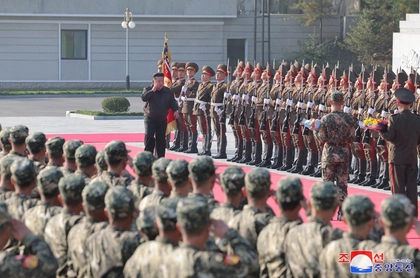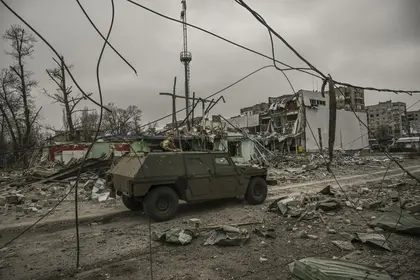The fighting around Avdiivka over the past two weeks has been fierce. Since Oct. 10 Russian forces have launched at least three massive armored assaults on the town in attempted pincer movements to surround the city from the north and south.
The armored columns sent by the Russians have become sitting ducks, with as many as 1,000 Russian troops killed in action every day, according to official Ukrainian tallies. The images and drone videos of tanks being destroyed are impressive, and many analysts, pro-Russians included, are saying this has been Russia’s biggest defeat of the war so far.
JOIN US ON TELEGRAM
Follow our coverage of the war on the @Kyivpost_official.
But the battle is far from over.
Industrial-age kurgan
The population of Avdiivka before the 2022 full-scale invasion was about 30,000. Today there are estimated to be fewer than 2,000 left, living mostly in basements under continual artillery fire. The city is within artillery range of the once state-of-the art, now-destroyed Donetsk airport, which has been an important objective for both sides since was broke out in 2014.
Russian-backed separatists captured Avdiivka in April 2014. In July Ukrainian forces took it back and maintained control of the contested Donetsk airport.
The airport was completely destroyed and overrun by Russian-backed separatists in Janurary 2015. At that point each side established its front lines as a series of defensive fortifications that have remained more or less static, even after Russia’s full-scale attack on Feb. 24, 2022.

North Korea UN Representative Denies Pyongyang Sent Troops to Russia
It’s become a high-caliber king-of-the-hill battle for a toxic hell realm, literally a massive pile of industrial waste.
In 2016 I traveled up and down this frontline for a reportage about the so-called “Gray Zone,” the strip of no-man’s land 15 to 20 kilometers wide and more than 200 kilometers long, separating territory controlled by Kyiv on one side and Moscow-backed separatists on the other.
While driving through and around Avdiivka, often over circuitous routes to avoid the sporadic shelling, all roads seemed to have a view of the Avdiivka Coke and Chemical Plant spewing smoke into the sky. Adjacent to the factory was the huge slag heap, known as Terrikon. The coke plant, built in 1963 to fulfil the needs of Mariupol’s steel mills some 140 kilometers away, is the largest in Europe. Coke, a solid fuel made by heating coal in the absence of air so that the volatile components are driven off, is needed for smelting iron ore to make steel. The plant also produces benzine, coal tar, coal oil, ammonium sulphate and coke gas.
I’d never seen a slag heap (also known as a “spoil tip”) before coming to the Donbas, which is full of them. Even the name, Terrikon, has infernal overtones. Driving around the city, Terrikon looms over the horizon, rising slightly above the steppe beyond the chemical plant like a grayish black, ancient Scythian kurgan, or burial mound. I tried to imagine how toxic it must be.
From time to time the Russians hit the plant with artillery – most recently on Sept. 28.
Like the Azovstal steel plant in Mariupol, the coke plant was a monument to Soviet industrial glory, and then to post-Soviet oligarchic murk. Both are owned by Ukraine’s richest man, Rinat Akhmetov. Both are quintessentially Donbas.
Today the Russians are feeding thousands of troops and armored vehicles into a wall of fire in a desperate effort to take Terrikon, from whose heights they can control Avdiivka. It’s become a high-caliber king-of-the-hill battle for a toxic hell realm – literally a massive pile of industrial waste.
In the past two weeks pro-Ukrainian social media has been celebrating the slaughter of columns of armor and infantry looking more like the Keystone Cops than the second mightiest army in the world.
But not everyone can celebrate the Russians’ senseless assault.
A filmmaker in the trenches
Oleh Sentsov, a Ukrainian filmmaker, writer and activist from Crimea, has perhaps more experience of the Russian invaders than just about anyone else. In 2014 he was arrested by occupation authorities in Crimea and sentenced to 20 years in a Russian prison, before being released in a prisoner exchange in 2019, after extended hunger strikes.
In 2021 Sentsov’s highly acclaimed film about the wild 1990s criminal subculture in Ukraine, Rhino, was presented at the Venice Film Festival.
When Russia’s full-scale attack came, 45-year-old Sentsov joined the fight. Since then, he’s been wound at least three times.
Oleg Sentsov: "We just left the battle - those who remained. We fulfilled our task, took a very difficult and very important line. There were close battles. They threw grenades. Three soldiers have shrapnel wounds. One is serious. I must have a contusion. It's not difficult. I'll… pic.twitter.com/uayCO4pUd7
— Ukraine Front Line (@EuromaidanPR) July 9, 2023
Last Friday, Sentsov posted a long message on his Facebook page, saying he had just been where the fiercest fighting is taking place, presumably Avdiivka.
He describes how his assault group, along with two others took partial control of a Russian trench:
“The first group, mine, was able to get hold of the enemy’s trench and immediately engage battle in two directions. The second group went into another trench, destroyed the enemy, but was knocked out of there by enemy reserves that pulled up. The third group took a hard fight and almost all of them died at the beginning of the operation.”
Sentsov doesn’t mention Terrikon, but he does mention how “the orcs advanced an endless number of infantry and armored groups, which were mostly destroyed by our artillery, FPV drones, and tanks”; and how those tanks rolled past his trench “with infantry hanging from them like monkeys on trees.”
He describes how the enemy managed to pound them out for 50 meters and how it became a grenade lobbing contest with “the hum of armor giving the enemy confidence to shout: ‘Surrender!’”
Sentsov’s group of 13 soldiers had one seriously wounded and several lightly wounded. Sentsov came out with a fragment from the underbarrel of an automatic grenade launcher under his ribs.
Once in a safe place, Sentsov corroborated the reports of a Russian fiasco visible from drone footage. “But I saw all this from a broken trench, and the view isn’t very good from there, though there are many other feelings.”
He acknowledged the many videos and enemy casualty stats and the joy it brought to wipe out so many adversaries. “But there are no statistics on the number of victims,” he added. “Behind each number is someone’s life, and the destroyed universe of relatives. This grief remains mainly in the families of the victims and their relatives. Eternal memory to fallen heroes...”
As I continue to read and watch the reports coming from Avdiivka, I keep hoping Sentsov will survive. I hope he makes a film about his experience – a film that will act as some colossal kurgan blending in with the steppe to honor the dead in eternity.
But as a filmmaker, Sentsov will of course need to make his monument out of light.
You can also highlight the text and press Ctrl + Enter






